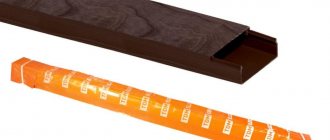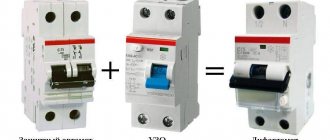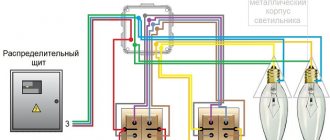How to connect an old switch
The wires should be routed well, fixing them with plaster.
It is important that the new wire has a cross-section no smaller than the one that was connected to the switch. If the wiring is carried out externally, it can be laid using cable ducts
Before dismantling the wiring from the old box, you need to find the phase wire, which can be determined with a voltage indicator, temporarily turning on the electricity supply. Next, you need to insert a junction box into the new switch socket, strengthening it with alabaster, cement or plaster.
Then all that remains is to connect the wires in this sequence: first the phase, and then everything else. The wires running in the groove must be covered with cement or putty. Next, all that remains is to fix the switch in its new location and complete its assembly.
In fact, the question of how to move the switch to another place or to another wall is not difficult; the main thing is to adhere to safety rules when working with electricity.
Using a cable channel
Relocating the switch with laying the wiring in the grooves provides for subsequent repairs of the wall covering. If the apartment has undergone a new renovation and you don’t want to damage the walls, then open wiring is done. It is also necessary on wooden walls where grooves are not allowed. Plastic cable channels are used for it.
From the junction box to the switch socket, the base of the cable channel is vertically fixed to the wall surface in a new location. Fastening is provided with dowels. The wires are neatly placed in the cavity of the base, and a plastic cover is installed on top.
This connection method has one drawback - the channel is noticeable on the wall and somewhat spoils the interior. However, it can be selected by color, which will help smooth out the impression somewhat.
Features of transfer in houses of various constructions
Grooves for electrical wiring
Differences in the methods of lengthening or shortening the wiring connected to the outlet appear mainly in the material of its walls. On this basis, city houses are divided into panel-type buildings, which are modular structures made from standard reinforced concrete slabs and brick buildings
From the point of view of transfer, walls that can be of particular importance are:
- Purely concrete surfaces covered with wallpaper, for example.
- Finished with plaster or plasterboard boards.
- With decorative fiberboard coating.
For each of the wall conditions, a different method of laying cable cores is suitable. In the case of concrete and plastered surfaces, if it is necessary to extend the electrical wiring, it will be necessary to make grooves in them, into which an additional piece of cable is then laid.
The correct approach to laying an extension cord in the presence of decorative trim involves running it under the finishing material. In a new location, a hole is drilled to the diameter of the transferred socket. Current regulations do not prohibit external laying directly over decorative material, which is sometimes done if you want to design the wiring in a “retro” style.
Wiring without grooves - replacement
Owners of panel houses are often at a loss: how to change electrical wiring with a minimum of dirty, labor-intensive work. Such methods exist. Wiring without wall gating is conventionally divided into two types:
- "Fine installation". It is used when the design of a room must meet high demands. To lay the cable, take an electrical plinth (box), fix it to the walls, or a PVC channel, which is hidden under the finishing (panels, drywall).
- "Rough editing." It involves the arrangement of power lines in a metal or plastic sleeve, pipes along the surface of the walls. In an apartment building, this option is not popular due to its external unattractiveness. Although there are different solutions.
To install the cable under drywall, you will need a corrugated pipe, which will act as a protective sheath. A common method of attaching drywall is to a frame. There is enough space between it and the wall to accommodate the wiring. Pre-drilled holes will help you stretch the corrugation through the profile, which will then become the basis for the sheets. It is more convenient to take a profile with ready-made grooves. The corrugation is secured with clips and plastic clamps.
Don't ditch! How to do without gating walls
Possible causes of malfunction
To start repairing, you need to follow the following algorithm:
- Check all outlets. If one product does not work, they look for the reason in it.
- The electrical circuit is susceptible to breakage in weak points, for example, when connected by twisting or unreliable insulation. If everything is fine in the electrical outlet, a break is looked for in the junction box.
- Find out how the voltage went out - the devices stopped functioning or the machine was triggered before that.
- Determine whether the outlet is regular or special for high-power electrical appliances.
In one room there is light, but the socket does not work
The most common problem is when the lights in the room turn on, but the sockets do not work. At the same time, voltage is supplied to other rooms. Possible reasons for inoperability:
- exceeding the permissible load;
- failure of a cable section.
It is necessary to check the electrical wires in the panels, the working part of the power points. If the cable breaks or breaks, call an electrician, as new wiring may be required.
The most common problem is careless installation or damaged insulation. In this case, the indicator will show a power failure in the faulty area.
One outlet does not work, but the rest are working in one room
When one power point does not work, the cause may be a loose connection or melted insulation.
If during a visual inspection the cover is melted and the socket does not function, then the contact wire has burnt out. When disassembling the device, the burnt area is visible.
The problem may be in the wire itself, then you need to inspect the cable, check the condition of the core and insulation.
If overheating occurs repeatedly, there is a high probability of destruction of the core, so you will have to replace the faulty piece.
If the insulation breaks, put a cambric or electrical tape on the exposed area. Darkened contacts are carefully cleaned with sandpaper.
Another cause of failure is a short circuit (short circuit). A short circuit is determined simply - the closed section of the conductor is missing, and the inner part is covered with an oily coating. In this case, the socket cannot be repaired - only replaced with a new one.
The socket in the kitchen near the stove or hood stopped working
A stove, hood, and washing machine are appliances with a power above 2000 Watts that require separate sockets. The most common problem is choosing the wrong power point, which is designed for less power. In this case, replace the electrical outlet with a new one with the required value.
If the permissible power is exceeded, the wire may break. The problem should be fixed by a professional.
A separate machine is installed for powerful devices. It can be triggered by a current drop. To return the voltage to the outlet, you need to look at the machine and turn on the toggle switch leading to the kitchen.
What to do if the socket itself is broken, but there is voltage
Before starting repairs, make sure that the outlet can be repaired. The burnt device is replaced with a new one. If there is no voltage when checking with a multimeter, the wires are checked. After making sure that everything is in order with the conductors, proceed with the repair.
To repair you will need:
- screwdrivers;
- sharp knife;
- insulating tape;
- pliers;
- multimeter
Procedure:
- Before carrying out work, turn off the power to the apartment. It is prohibited to repair a live power point.
- Unplug devices from the electrical outlet.
- Use a screwdriver to remove the housing.
- Unscrew the clamping bolt and check the quality of the connections. Loose contacts are strengthened.
- Trim the melted ends with a knife or wire cutters. Repair damaged insulation using electrical tape.
- If the clamping bolt is broken, install a new one.
- After troubleshooting, reassemble the socket.
- Turn on the electricity and make sure the problem is corrected. To do this, you need to connect a low power device. If the outlet works without unusual sounds or odors, the repair was successful.
Why is it not profitable to install a meter on poles?
- Indoors, without exposure to cold or hot air, the device gives more accurate readings. The error of street meters, compared to home ones, can reach 10%. Considering the high cost of electricity for consumers, the amount to pay for electricity increases significantly.
- A meter that was installed on a pole will fail faster and will last a shorter time.
- Dust, humid air, wind, hail - all these natural factors cannot but affect the operation of the device. With this arrangement, electricity meters more often require repairs, and the accuracy of the indicators is often lost.
- When the meter is installed on the street, you need to monitor it. After all, even from hooligan motives, someone can damage the device, and theft is not excluded, despite reliable fastening and connection to the electrical network.
- Energy companies force people to install electricity meters on the street, often counting on additional profits. After all, if the meter breaks down or completely fails, the consumer needs to pay for a new control device, a new installation, a new seal.
- Also interested in the fact that electricity meters in the sector of private houses, dachas, and garden plots are located on transmission line supports are also those companies that sell meters and check them.
There are many reasons for concern among owners of plots in holiday villages, gardening partnerships, and in the private sector. And therefore the question is whether the requirement to move the electric meter outside the house and even the yard is legal.
Tools for work
Before starting work, you must prepare all the necessary tools:
- Preparing a groove for electrical wiring - a wall chaser or hammer drill, chisel, chisel, hammer.
- Making a nest - a hammer drill with a concrete crown of the required diameter.
- Repair, dismantling and installation - a Phillips screwdriver, a minus screwdriver with a narrow and wide tip, pliers.
- Laying and connecting wires - wire cutters, mounting knife.
- Control and measurements - tester or indicator screwdriver, tape measure, ruler.
- Sealing and finishing work - spatula for plastering and putty, sandpaper or grinding machine.
We should not forget that the work is carried out with the electricity turned off, which means a flashlight may come in handy. For work at height you will need a stepladder.
Wire extension options
When connecting wires, complete electrical contact must be ensured. A poor-quality connection will become very hot, which can lead to a fire. Good contact is ensured by 3 connection options: terminals, insulating clamps and soldering.
Via terminals
Two types of devices are used:
- spring terminals. They are disposable and reusable (the wires can be disconnected and reconnected many times). The conductor inserted into the terminal is automatically grasped by a spring-loaded lever mechanism. The device is suitable for cores made of any material;
- terminal blocks. The conductors in the terminals are fixed with a screw clamp. Undesirable for aluminum wires due to their fragility.
Terminal connectors are selected according to the diameter of the cores.
On connecting insulating clamps (PPE)
PPE has the form of a cap with a spring inside that fixes the ends of the connected wires. The connector is made of non-flammable material, which reduces the risk of fire in the contact area to zero. PPE is produced in different colors, which allows you to observe color markings during installation: phase, neutral and grounding are marked in different colors.
Connecting insulating clamps (PPE)
Soldering
Soldering iron skill required. The stripped ends of the wires are twisted and dipped into molten solder. The cooled connection is wrapped in several layers of electrical tape.
Forced cooling of a solder joint by immersion in cold water is not permitted. The temperature difference will cause microcracks to appear in the solder, causing the electrical conductivity of the connection to significantly decrease.
How to move an outlet
After studying safety standards and drawing up a preliminary diagram, the home master is faced with the question: how to properly move the outlet without disturbing the wall decor? A household socket has a dielectric base inside and a front panel on the outside. Dismantling the old socket begins with the front panel - it must be removed, that is, using a screwdriver, unscrew the screw with which it is attached to the dielectric base. In some types of models, the panel is secured to the inside using latches. In this case, you can pry it off with a knife with a thin blade. The front panel also needs to be removed when wallpapering a wall. In this case, the base of the socket is not removed from the installation box. Once the panel is removed, the dielectric base becomes accessible. Spacer tabs securely fix it in the box. By loosening both screws securing the tabs using a screwdriver, the dielectric base can be removed. Then the socket must be disconnected from the network wiring. The socket should be carefully inspected for damage, and if any is found, replace it with a new one.
Tips and tricks
- Twisting of cores is carried out subject to removal of 3 cm of insulation on both sides.
- Cleaning the contacts with fine-grained paper (sandpaper) is mandatory for better contact adhesion.
- If twisting is carried out rather than connecting using special devices, it is better to solder the finished structure with a lead-tin mixture.
- Always calculate the degree of load on the wiring and select a cable of the required cross-section. You should not play it safe by buying a cross section of a larger value; this is also unsafe.
- It is better to cut off the excess cable, twist the rest and hide it in the junction box.
Tools for work
Before starting work, you must prepare all the necessary tools:
- Preparing a groove for electrical wiring - a wall chaser or hammer drill, chisel, chisel, hammer.
- Making a nest - a hammer drill with a concrete crown of the required diameter.
- Repair, dismantling and installation - a Phillips screwdriver, a minus screwdriver with a narrow and wide tip, pliers.
- Laying and connecting wires - wire cutters, mounting knife.
- Control and measurements - tester or indicator screwdriver, tape measure, ruler.
- Sealing and finishing work - spatula for plastering and putty, sandpaper or grinding machine.
We should not forget that the work is carried out with the electricity turned off, which means a flashlight may come in handy. For work at height you will need a stepladder.
Loop creation technology
The loop method is the safest of all options. It involves not simply moving the old outlet up or down, but creating a new “point” in close proximity to the old one.
The main advantage of the daisy chain method is the ability to connect a new outlet, placing it on the section of the wall required for work, and at the same time keep the old one
The only drawback of this connection is that the cable from socket to socket is laid horizontally. Knowing that traditionally the branching to the same switches and sockets is laid in a vertical route, due to your forgetfulness you can inadvertently damage the wire.
In addition, if one of the cores is damaged at the switching point, then all the elements following it will stop working. Therefore, the fewer connection points the system includes, the more reliable it will be.
Selection of required materials
When using this method, material costs are minimized. In addition to purchasing the newest outlet for work, you need to prepare:
- wire of the appropriate cross-section;
- plastic socket box;
- hammer drill with crown D70 mm;
- indicator screwdriver;
- pliers;
- hammer;
- flat screwdriver;
- braid removal tool.
The wire itself does not have to be laid in a groove, but can be laid openly using a cable channel.
To transfer the connection point to a new location and avoid the procedure of wall slitting, it is recommended to use an overhead cable channel model
The choice of socket box model depends on the base material into which it is supposed to be buried. For concrete and brick walls, ordinary plastic “glasses” are chosen, and for plasterboard bases, models equipped with spacer legs are chosen.
Making a niche and installing a socket box
Before moving the hidden socket to another place, you need to prepare a place for installing a socket box and make a groove for laying a section of the electrical network. Having outlined the location of the future connection point, use a crown to drill a hole.
In the absence of one, you can use a hammer drill equipped with an impact drill or a grinder. In this case, holes are first drilled along the marking contour, and then individual fragments of the wall material are chopped off using a chisel.
The depth of the niche is made such that the floor is completely recessed into it, and at the same time there remains a margin of 3-4 mm
A “glass” is immersed in the prepared niche. The electrical cable coming from the junction box is inserted through its back wall.
The socket box is fixed in a concrete wall using gypsum mortar. After the mixture has hardened, the product is cleaned of gypsum residues, and its inner walls are wiped with scraps of fabric. To secure the socket box into a plasterboard or wooden base, the “glass” is immersed in the made niche and fixed using the side spacer tabs
Connecting a new point
Having measured the cable of the required length to power the new point, one end of it is connected to the terminal blocks of the old socket, and the other to the contact part of the new “point”. The neutral, phase and ground wires are connected in parallel directly to the socket contacts.
To prevent short circuits between conductors, each core is insulated with a plastic braid. When connecting the cable, it must be removed. To make the task easier, use a cross-connecting knife, which can easily remove the insulation without damaging the core.
The work of stripping the braid should be done as carefully as possible, because if the core turns out to be damaged or defective, it will certainly “prove” itself very soon.
Neutral and phase conductors are allowed to be connected directly to the contacts of the socket, and the protective PE conductor only through a branch using a terminal block
When dealing with a PE conductor, keep in mind that according to the PUE, it is important to maintain its continuity. After all, if the grounding conductor on one of the sockets breaks, all other devices will be ungrounded. Having connected the neutral, phase and grounding conductors, all that remains is to fix the working part of the product in the installation box and install the decorative cover
Having connected the neutral, phase and grounding conductors, all that remains is to fix the working part of the product in the installation box and install the decorative cover.
Power connection
At this stage, measure the length and cut the cable. Be sure to leave a margin of a few centimeters on both sides. The photo above shows the stock inside the socket, I rolled it into a kind of rings.
Important note. If the apartment uses aluminum wiring, there is no need to install a new copper cable
In this case, I recommend using aluminum wires with a cross section of 2.5 mm2. This way there are fewer connection problems.
Relocating a Home Electrical Outlet
Relocating a telephone jack or jack is not easy and often involves quite a bit of intervention. It's potentially not a job like you do because you need different specific skills and the ability to cause disasters is quite high. However, the procedure can be easily described, and if you follow the directions and are careful, you can also present interesting alternative solutions. The first step is to turn off the power in general or, if possible, to the relevant room. Then remove the grip, remove the mask and try to figure out the shortest path to reach the desired position where you need to replace the grip point. Once the position has been identified, it is best to trace the path to the flow using a pencil.
Now we make the power connection in the old box. To do this, we first turn off the phase in order to work safely.
Tools for working in concrete
This measure should not be underestimated as it allows the material used for filling to be retained. Once you reach the point where you want to position the new point, you need to chisel into the wall, creating a suitable enclosure to insert the box that will hold the sockets. Once this is done you will need to insert a perforated track along the track where the threads will be transferred
It is important, before going along the route, to stop the frontovit and not tie the cables in the part that will be covered by the wall. We use Vago 2273-203 terminals with paste, which are very useful in this case
If such terminals with paste are used, you can also use copper wire VVG 2x1.5. But it’s better to use AVVG 2x2.5, as in my example.
Using terminal blocks and spring terminals
In addition, it is necessary to use wires with a suitable diameter, at least equal to those previously used, to avoid possible problems. Moving actually involves a number of complex operations, and it is not always convenient to do it yourself. If you know the positions of already made tracks, and if you want to navigate through already planned environments or control them with preset switches, you can also try to pass wires into passes already present, although the operation is usually For these reasons, you can choose external solutions , which do not involve intervention, or use products such as those offered by Strozzafili, which allow passages to pass wires inside wall panels in a much more convenient and quick way. Now we lay all the wires neatly in the external outlet, cable channel and old box.
We turn on the machine at the entrance and check.
Why move the switch?
In real conditions, the need to move a light switch indoors may arise for various reasons:
- Inconvenient height position. The switch is too high for small children to reach. Or, on the contrary, the children have already grown up, and he is too low - he has to bend down.
- Access limitation. For example, he ended up behind a cabinet or bar counter.
- The desire to rearrange the furniture, and the switch turns out to be closed.
- Increased convenience. Ensuring that the light is turned on from another room or from several places, bringing the switch closer to the bed or chair, etc.
- Consequences of repair. A good reason is to combine several rooms. Moving, for example, the kitchen into the living room, dividing a large room into several rooms, reinstalling the front door, etc.
Perhaps the opportunity has arisen to install a new structure, but it does not fit in its original place.
Safety precautions
When moving or repairing a switch, remember that this is an electrical device operating at a voltage of 220 V, which is dangerous for humans. All work should be carried out only after turning off the electricity in the input panel.
The absence of voltage should be checked with an indicator screwdriver or tester. It is necessary to completely exclude inclusion by another person who is not aware of the work being carried out.
General rules for such events should also be provided. All tools must be the correct size and in good working order. The workplace must be cleared of foreign objects.
Control devices must first be checked for functionality.
The need to move the switch to a new location can be caused by various reasons. The work can be easily done with your own hands if you have the necessary tools and know the basic rules.
It is important to comply with safety requirements and exercise maximum care and attention. Modern switches are easy to install, but you must act strictly in accordance with the instructions.
Important clarification. Will be useful to everyone without exception
The socket box is purchased either plastic (for working with brick and concrete walls) or with spacer legs (for wood or drywall). This is a modern, fairly fast and budget option for how you can easily move an outlet in the house without gating. It is becoming an increasingly popular way of equipping offices, shops, and small businesses with the required number of sockets and other electrical parts, especially if this work must be carried out in panel structures.
We must not forget (just!) to always leave an installation wire margin of 10-15 cm and never connect aluminum and copper wires to each other.
Layout plan for additional potential equalization boxes
The electrical design of a three-room apartment contains one sheet of arrangement of DUP (additional potential equalization) boxes.
Note: Additional potential equalization is the connection of all metal communications and metal housings of the apartment's electrical installations into one electrical circuit. The connection is made with copper wire PV1, cross-section 2.5 mm2. All these wires are connected to the terminal block of the additional potential equalization box (KDUP). The terminal block of the KDUP box is connected to the PE bus terminal of the common apartment electrical panel. The connection is made with a PV wire with a cross-section of 4 mm2, in a pipe of 16 mm.
Tips and tricks
- Twisting of cores is carried out subject to removal of 3 cm of insulation on both sides.
- Cleaning the contacts with fine-grained paper (sandpaper) is mandatory for better contact adhesion.
- If twisting is carried out rather than connecting using special devices, it is better to solder the finished structure with a lead-tin mixture.
- Always calculate the degree of load on the wiring and select a cable of the required cross-section. You should not play it safe by buying a cross section of a larger value; this is also unsafe.
- It is better to cut off the excess cable, twist the rest and hide it in the junction box.
We move the device to the adjacent wall
When deciding how to properly move the outlet, you need to understand which method will be optimal:
- extension using a cable;
- extension by adding a new one, similar in cross-section;
- creation of a parallel leased line.
The last option is to pull a new wire from the junction box and is considered the most reliable and safe. Moving a socket this way with your own hands allows you to bring a separate point to any wall of the apartment, but it requires significant material and time costs. The work is carried out sequentially:
- Check whether the electricity is turned off at the switchboard; if not, then turn off the power to the room.
- Open the junction box from which the cable of the point intended for installation is powered, disconnect the wire, dismantle the old device and wiring.
- Fill the hole remaining after the dismantled line with construction plaster.
- In accordance with the developed scheme for moving the socket in the apartment, lay a new groove. The size of the new groove is calculated depending on the diameter of the wiring, taking into account a layer of finishing material 15-20 mm thick. Before punching a groove with a hammer drill, it is advisable to mark the wall.
- Once the groove is ready, lay the wire along it.
- At the site of the future device, use a hammer drill with a special attachment to punch a hole for installing a mounting box with a diameter of 60 mm and a depth of 50 mm. Coat the made nest with alabaster or building plaster, install the box, wait until the solution dries.
- To fix the cable in the groove, dowel clamps are used, securing them every 50 cm.
- When laying the cores, the end must be inserted into the junction box, connected to the new wire by soldering, and secured at the top with electrical tape. It is not recommended to twist the wires, although it is easier and faster, as it can lead to overheating and short circuit.
- Pull the other end to the new mounting box and secure it. For a more reliable connection of the wires to the connectors, the cores can be wrapped around the installation bolt.
- Fill the groove with new wiring with concrete mortar.
Output of a new branch
This method requires more time and effort, but allows for the safest transfer of an electrical outlet.
The method, which involves installing a new line, is often used in panel houses, where the wires are literally walled up in a concrete wall, and therefore it is not possible to remove them. In this situation, they are simply de-energized and left in place, and a separate groove is laid to power the new outlet.
Grilling the wall and installing the “glass”
To install a new line, the first step is to turn off the electricity in the room where the work will be carried out. On the wall, using a ruler and pencil, mark the route along which the new groove will be laid.
Using a hammer drill or grinder, a groove is cut out in the wall along the intended route. The depth of the groove is made such that the wire laid in its cavity does not protrude above the surface after installation is completed.
To install a new connection point in the intended location, using a hammer drill equipped with a crown, hollow out a “nest” 50 mm deep. The walls of the niche are thoroughly cleaned of construction chips and dust.
The installed “glass” should not protrude above the surface. If the depth of the niche is not enough, you can carefully cut off the back wall of the socket box.
Switch repair
It is not always necessary to throw out the old switch and replace it with a new one. Sometimes it is enough to repair it. The design of the switch is quite simple and in the event of a breakdown it can be repaired without much difficulty. If you carefully examine the disassembled switch, you can understand that the main function in it is performed by a contact pair, which moves from one position to another by mechanical force. In one position the electrical circuit is connected, in the other it is disconnected.
Required tools and materials
To disassemble and reassemble the switch, you only need one tool - a flat-head screwdriver, 3-5 mm in size. To clean the contacts, you need a piece of fine-grain sandpaper or a needle file.
The switch is disassembled using a regular flathead screwdriver.
How to disassemble a switch
The process of disassembling the switch was described above. For convenience, we present it here again.
- If the switch is already in (on) the wall, disassembly begins by removing the key. This is easy to do by prying it off from the side with a screwdriver.
- Next, unscrew the two screws securing the protective frame to the base.
- After this, the base is removed from the socket box, for which two screws of the spacer mechanism are loosened. There is no need to unscrew them completely; after one or two turns on both sides, the spacer legs will loosen and the switch will fall out freely, hanging on the wires.
- Next, the wires are disconnected. To do this, loosen the two screws that hold the wire in the terminal. Disassembly is complete. The switch is removed from the socket box, then the wires are disconnected from it
Modern switches consist of a non-removable base, which is simply replaced in case of damage.
Cleaning contacts
If the switch is unstable (it turns on and sometimes does not turn on the lamp), most likely the reason lies in burnt contacts. Upon careful inspection, such contacts may appear slightly charred or even melted. This happens because the wire is not firmly secured in the terminal block. Another reason may be a voltage surge in the network at the moment of switching on. A lamp that is too powerful can also cause damage to the contacts over time. Be that as it may, the contact needs to be restored, then it will continue to serve properly. To do this, it is sanded with fine sandpaper until a uniform metallic color appears.
Use fine sandpaper to clean the contacts.
Sometimes the conductor may be tinned, that is, treated with tin. Then, instead of sandpaper, it is better to use a small file - a needle file.
Other possible problems and solutions
Other problems with switches rarely occur. But there are times when a foreign body or some kind of debris gets inside the switch. For example, during renovation. Then it needs to be disassembled and thoroughly cleaned of all excess; it is advisable to blow out the base with a vacuum cleaner. As a rule, after this the operation of the switch is restored.
How to assemble a switch
Assembly occurs in reverse order. If the repair is being carried out for the first time, you can lay out the parts on the table in the order of disassembly or photograph them step by step. When repairing a single-key switch, the location of the wires does not matter. But if it has two or three keys, then in order to avoid confusion, it is better to immediately mark the incoming core with a marker. They can also mark the place where it is connected.
When installing a double-lever switch, it is necessary to correctly connect the input conductor (phase), which is best marked during disassembly
You can check the result of the repair after installing the base in the socket box. To do this, you need to turn on the power supply on the panel and test the switch. If it works normally, you can complete the assembly and install the protective case and key.











